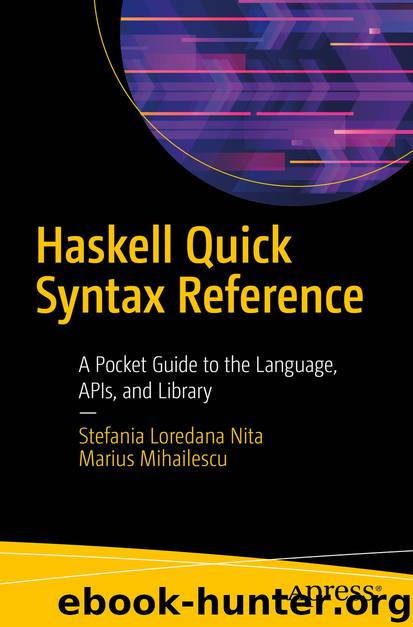Haskell Quick Syntax Reference by Stefania Loredana Nita & Marius Mihailescu

Author:Stefania Loredana Nita & Marius Mihailescu
Language: eng
Format: epub
ISBN: 9781484245071
Publisher: Apress
The Three Rules
You have seen that a monad must follow three rules: right unit, left unit, and associativity. These three rules show you the relation between a computation, the return function, and the binding operation.
All monads are instances of the Monad type class from Prelude, which is defined as follows:class Monad m where
return :: a -> m a
fail :: String -> m a
(>>=) :: m a -> (a -> m b) -> m b
(>>) :: m a -> m b -> m b
In this definition, the last rule can be expressed in terms of the third rule. Note that (>>=) is read as “bind,” and (>>) is read as “then.”
Before going further, we need to mention that the do notation works great with monads; it acts as syntactic sugar for operations. You will see some examples in the next sections.
Download
This site does not store any files on its server. We only index and link to content provided by other sites. Please contact the content providers to delete copyright contents if any and email us, we'll remove relevant links or contents immediately.
| Computer Vision & Pattern Recognition | Expert Systems |
| Intelligence & Semantics | Machine Theory |
| Natural Language Processing | Neural Networks |
Algorithms of the Intelligent Web by Haralambos Marmanis;Dmitry Babenko(8300)
Test-Driven Development with Java by Alan Mellor(6724)
Data Augmentation with Python by Duc Haba(6639)
Principles of Data Fabric by Sonia Mezzetta(6390)
Learn Blender Simulations the Right Way by Stephen Pearson(6290)
Microservices with Spring Boot 3 and Spring Cloud by Magnus Larsson(6161)
Hadoop in Practice by Alex Holmes(5958)
Jquery UI in Action : Master the concepts Of Jquery UI: A Step By Step Approach by ANMOL GOYAL(5807)
RPA Solution Architect's Handbook by Sachin Sahgal(5559)
Big Data Analysis with Python by Ivan Marin(5365)
The Infinite Retina by Robert Scoble Irena Cronin(5249)
Life 3.0: Being Human in the Age of Artificial Intelligence by Tegmark Max(5147)
Pretrain Vision and Large Language Models in Python by Emily Webber(4328)
Infrastructure as Code for Beginners by Russ McKendrick(4089)
Functional Programming in JavaScript by Mantyla Dan(4038)
The Age of Surveillance Capitalism by Shoshana Zuboff(3950)
WordPress Plugin Development Cookbook by Yannick Lefebvre(3804)
Embracing Microservices Design by Ovais Mehboob Ahmed Khan Nabil Siddiqui and Timothy Oleson(3608)
Applied Machine Learning for Healthcare and Life Sciences Using AWS by Ujjwal Ratan(3579)
